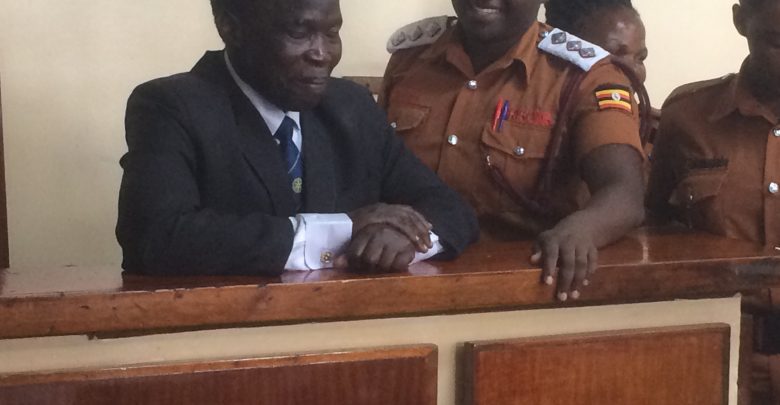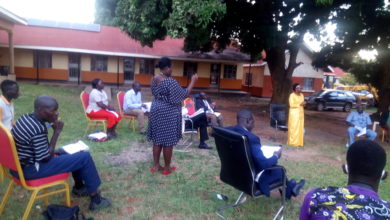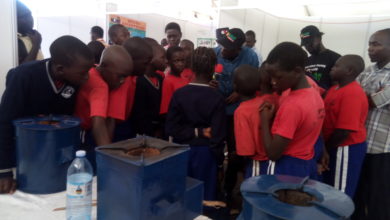
Global Politics
UGANDA: HON. JUSTICE STEPHEN MUBIRU CAUTIONED ASSESSORS NOT TO BE INFLUENCED BY OUTSIDE OPINION
“Now, lady and gentlemen Assessors, we have been at this trial for over three years. In the course of this hearing, you should have heard a lot information outside court regarding this case.
You are cautioned that yours should not be inflamed by such information; you are limited to only that information that has been laid before you this court. Therefore, the following should be your sources of facts and other consideration.” Justice Mubiru warned assessors.
GULU CITY- TUESDAY, JULY 23, 2024.
By Okumu Livingstone Langol (The Guardian News UK)
Justice Mubiru, one of the panels of four Judges of International Crimes Division sitting in Gulu High Court for trial of Thomas Kwoyelo aka Latoni, the former LRA rebel commander that his case is one of the longest give his summing submission as follow:
Part I verbatim.
Time, it was at about 11.00AM local African time in Gulu when the four Judges of I.C.D walked in the court room session, mid morning atmosphere changed to glumly, to everybody expectation debate that what would be the fate of Thomas Kwoyelo.
Justice Mubiru echoed, thank you very much, my lord as begin to lay down his submission, first one is the indictment, and you have also listened to oral testimony by over fifty witnesses from the prosecution and four witnesses from defense including the accused.
Before court you have seen document tendered, so the third source is the documentary evidence. There was also a video recording from all the parties and yesterday highlights of those submissions from all the parties were given to court.
In a nutshell, we are summing up to you this afternoon, so any information o the principles we are about to guide that is outside those sources you should disregard entirely, the other factor you ought to bear in mind is the nature of this trial. We under conducted a trial involving international crime alongside crimes under our own Penal Code Act.
So, the principles we are guide you concerned both international law as well as our domestic law. You are also now familiar with some that are purely of law will be decided by the panel, you are not required to render an opinion on such questions, your opinion will be limited to two areas.
You are also now familiar with some of the arguments that have been arising from time to time. Questions that are purely of law will be decided by the Panel, you are not required to render an opinion on such questions. Your opinion will be limited to two areas.
The first area, you are required to make findings of fact that is whether or not the contested events actually happened as alleged in the indictment or at all.
The second area is the ultimate question; should we find the accused person guilty or not guilty. So you will limit your opinion to those two areas.
In arriving at your opinion, you bear in mind that the accused is presumed innocent; he has nothing to prove before this court. Therefore, the burden is entirely on the prosecution to prove his guilt on each count.
And in arriving at that conclusion, you don’t rely on any weaknesses or gaps in his version.
It is the duty of the prosecution to prove this case to the standard required which is beyond reasonable doubt.
How you arrive at that conclusion is by considering evidence from both sides on each count and each element of each count.
So don’t rely on evidence from one side to draw your conclusion, you should have considered both sides of the case.
By the nature of oral evidence, sometimes there are contradictions and inconsistencies. An inconsistency arises if the witness does not maintain the same position about their statements to the court and elsewhere. They say one thing at one point in time and a different thing at another point in time over the same fact.
A contradiction is where two witnesses or more have different versions that are irreconcilable over the same fact. Both are treated the same under the law of evidence. They are classified either as minor or as grave. They are minor if they don’t concern a fundamental decision in the case. For example, if it is about time of arrival at a certain place and that time is not critical you can classify it as minor. But it can be grave if the decision to be made stands on the accuracy of that information.
For minor ones they can be disregarded unless they are evidence of untruthfulness or the grave or major contradictions. There should be an explanation.
If there is none, that evidence runs the danger of being rejected or disregarded.
One of the factors that may guide you in making that determination is the lapse of time between the occurrence of these events and the actual trial.
The indictment covers events which occurred in 1993 up to 2005.
Sometimes witnesses were required to have a recollection of occurrences in their childhood. So you have witnesses who were required to recollect events which happened over 20 years ago. So as you consider their evidence, bear in mind could they be mistaken about things due to lapse of time or they are they telling lies deliberately.
The other evidence principle that will guide you in considering the evidence before court, regards what we call accomplices, participants in the commission of the offences. Some of the witnesses who appeared before court admitted having been recruited into the Lord’s Resistance Army.They testified about events in which they were active participants. When faced with such evidence, the law requires you and us to be conscious because accomplices have a tendency of trying to minimize or trivialize their participation while exaggerating the participation of others.Sometimes they may be tempted to exculpate themselves, to give excuses for their benefit while at the same time incriminating others.
A conviction can be based on their evidence but after careful scrutiny but that is not the case before court.
The best way of determining whether that is not the case, is the extent to which they admit their own culpability in the criminal act.
If they are admitting more or less to the same extent as they are incriminating others, they are more reliable. But if they attempt to exculpate themselves while incriminating others you have to be very conscious with such evidence.
The other area is evidence of identification; visual identification, a witness who claims to have seen another sometimes may be mistaken although honest, he may be honest but mistaken.
So before you are convinced by their evidence, you must subject it to a test of possibility or the lack of that possibility of mistake.
You consider the following; before the event which they claim to have witnessed. Did they know the accused person? If they did, what were the circumstances of that familiarity? And if the circumstances are known, when was the last time, they saw the accused person before the event? Some circumstances afford reasonable time to get to know a person very well, others don’t.
For example, if they met at a social event as opposed to being neighbors. Then the time, if they last saw the person years ago as compared to a week or a month before the event. So you should analyze that aspect of familiarity.
The second, the conditions prevailing at the time of the incident.
Conditions such as light, is it during day time or night time. If it is during night time, was there any light at all? If there was, how bright was it by virtue of its source?
Also consider whether the light aides or inhibits sight of the ability to see for example if it is shining directly into someone’s eyes and it is bright, it has the tendency to blind rather than aid sight. So you consider light.
Second you consider the distance between the person identified and the identifying witness. The longer the distance they are apart the more difficult it is to identify. The closer they are, the easier it is to identify.
You also consider whether or not the period of time they were under observation was adequate.
If they spent hours together as opposed to seconds or minutes, it will affect your determination as to whether the time was sufficient to aid proper identification.
You will also consider factors that can inhibit correct identification such as fright, someone under extreme fear or where there are distractions, a lot of activity going on that distracts attention. There could also be obstacles, objects that prevent direct line of sight. For example, if you are hiding in the bush and you are just peeping through grass or leaves that kind of situation.
Lastly, about identification; consider both factors which favors identification and those which are unfavorable for identification, then you decide which of these present a better quality.
Are the factors in favor overwhelming or is it the factors that are unfavorable that are overwhelming?
If you are in doubt that the witness perhaps was mistaken, were there additional aids for identification such as where the person speaks so that there are identified visually and by voice, that could help in ruling out mistake, if the person never spoke while at the scene.
Then we have a concept of corroboration, additional independent evidence. Whenever you have a doubt about a piece of evidence standing alone, you look out for independent evidence elsewhere. There are a few situations where additional evidence is required by law, but those instances do not arise here. The ones that arise come out of good practice of courts.
The first one is accomplice evidence, I mentioned earlier if you have any doubt about an accomplice, you can find corroboration that is independent evidence that proves the same fact.
The second is identification evidence under difficult circumstances.
Now as regards sexual offences, there is no requirement of corroboration. The evidence of a person who claims to be a victim is good on its own provided you believe that witness, you don’t have to look elsewhere, if you believe the witness, that witness can be the basis of the finding of fact.
It is only if you have reason to doubt that witness that you should look for corroboration.
The other principle that will guide you relates to circumstantial evidence. Circumstantial evidence is where you don’t have a direct eye witness, someone who was present to see or witness a fact in issue but that fact is of such a nature that it can be proved by putting together different pieces of evidence.
For example, if you see someone alive and within the next 30 minutes you find this person dead with multiple stab wounds on their body.There is no direct evidence of stabbing so the circumstantial evidence is being seen alive for a short time before you are found dead with these types of injuries. Can you make the finding that this person has been killed rather than committed suicide? In order to come to that conclusion, the circumstances must point to only that conclusion.
The moment the wounds’ cause can be explained in a manner inconsistent with the killing by another, that evidence is not strong enough to support the conclusion that the person was killed. But if you find there is no other explanation for those wounds except that they were inflicted by another person, then they can support that conclusion.
So look out for reasonable explanations not outrageous ones, if they are lacking you can rely on circumstantial evidence to make your own conclusions.
Lastly but not the least, the major defiance presented by the accused is alibi, he was never at any of these scenes of the alleged offences. He does not have to prove it; it is the duty of the prosecution to disprove that defiance of alibi. It is disproved by adducing credible evidence which places him at the scene of crime. You have no doubt whatsoever that on basis of that evidence he was at the scene of crime and nowhere else.
If you have any doubt, then his defense succeeds.
So that is in short a set of principles which should guide you as evaluate and analyze this evidence before you render your opinion.
You are reminded that we began the trial with 93 counts, the court found that only 78 of them could be sustained to the next level of requiring evidence’ part I





